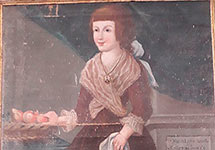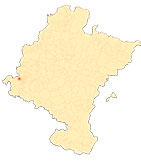Sanctuary of Nuestra Señora de Codés
By Pilar Andueza Unanua
Blessed cloths, miracles and votive offerings
If the first miracle was vital for the expansion of the devotion, no less so was the presence in the sanctuary of a hermit with a reputation for holiness, Juan de Codés, who is credited with the blessing of the sanctuary's famous cloths, which were attributed with therapeutic and curative properties.
Amiax placed Juan de Codés entering as a hermit in Codés in 1530. There he remained for ten years ministering to the faithful and pilgrims. But, desiring a fully eremitical experience, he withdrew to another more isolated Shrine of Our Lady of Fair Love up in the mountains where he spent seven years dedicated to the contemplative life. After a trip to Rome, he returned to Navarre in 1547 and, once again installed in his hermitage, he heard that Pedro de Bujanda, a young man from Torralba who had been wounded in the neck during a brawl in Logroño, had been taken to the sanctuary of Codés. Juan came to his aid and, after celebrating Mass, blessed before the Virgin some linens that he placed over the wound forming a cross. The prompt healing of the young man spread rapidly among the parishioners. From then on, the cloths of Codés became very famous for healing the sick and crippled.
Amiax dedicated the fourth book of his Ramillete to narrate how these canvases were to be blessed and collected in detail sixty-one healings of devotees who came to them in search of relief. In most of these healings he recorded the names of the persons, their place of origin and the ailment suffered. Only in a few cases did he give dates. Most came from towns in the Merindad of Estella, although individuals also came from other areas of Navarre, as well as from La Rioja, Alava and even further afield, such as Sos del Rey Católico and even Zaragoza. Among the rehabilitated there were people of all ages, children, youths and adults, and of all social conditions, finding both religious and above all seculars, among which some relevant surnames of the Navarrese nobility such as Eguía, Vélaz de Medrano or Beaumont stand out.
The ailments suffered were varied in nature: sores, ulcers, swellings, broken bones, blindness, infected wounds, crippling, pain, wounds caused by stabbing or roasting, by falling from roofs, walls or horses, by stoning, axe cuts, sickle cuts, thorns, crushing by millstones, bites from rabid animals or victims of the plague of 1599.
As a result of these healings, the grateful devotees offered the Virgin alms: mainly money, wheat and jewelry, as well as votive offerings, either in painting (showing the portrait of the person healed, the scene of the accident or illness), or in the form of the part of the body healed. Thus, for example, in the inventory of goods made in 1664 there were three hearts, two breasts, a leg and seven pairs of eyes. In 1721 María Josefa de Pedro, a native of Logroño, was offered to the Virgin of Codés to cure her arm, once the doctors had decided to amputate it. As she was healed, she gave the sanctuary a wax arm as a testimony of her healing. Today, a picture of this votive nature painted by Diego Díaz del Valle in 1793 is preserved on the staircase of the hospice. It portrays María Luisa Acedo y González de Castejón, born in 1787 in Mirafuentes, and cured when she was a child, as attested by the following registration: "Dª Maria Luisa Azedo / y Castejon, daughter of / Dn Diego Azedo / y de Dª Maria Concepcion / Castejon y Sarria / la ofrecieron sus Padres a Nra Sra / de Codes por ha / verla librado de / peligro en / en / fermedad de edad / de 3 años a 4".
AMIAX, J. de, Ramillete de Nuestra Señora de Codés, Pamplona, By Carlos Labayen, 1608.
History of Our Lady of Codés. Sencillos apuntes sobre Codés, Logroño, Cofradía Administradora del Santuario de Nuestra Señora de Codés, 1939.
ANDUEZA UNANUA, P, "El Santuario de Nuestra Señora de Codés: historia, arte y devoción", in FELONES MORRÁS, R. (coord.), En montes y valles. Santuarios en Tierra Estella, Estella, Cofradías de Nuestra Señora del Puy, Nuestra Señora de Codés y San Gregorio Ostiense, 2017, pp. 52-65.
AZANZA LÓPEZ, J. J., Arquitectura religiosa del Barroco en Navarra, Pamplona, Institución Príncipe de Viana, 1998.
GARCÍA GAINZA, M. C. and others, Catalog Monumental de Navarra. Merindad de Estella II**, Pamplona, Institución Príncipe de Viana, 1983.
ITÚRBIDE DÍAS, J., Between the Renaissance and the Baroque: Ramillete de Nuestra Señora de Codés (A bouquet of Our Lady of Codés)Piece of the month. Chair de Patrimonio y Arte navarro, 2016.
ORDOÑEZ, V., Santuario de Codés, Colección Temas de Cultura Popular nº 343, Pamplona, Diputación Foral de Navarra, 1984.











